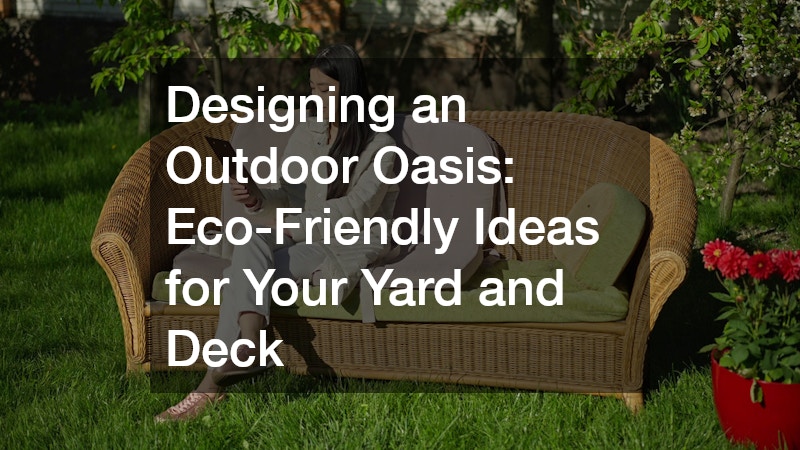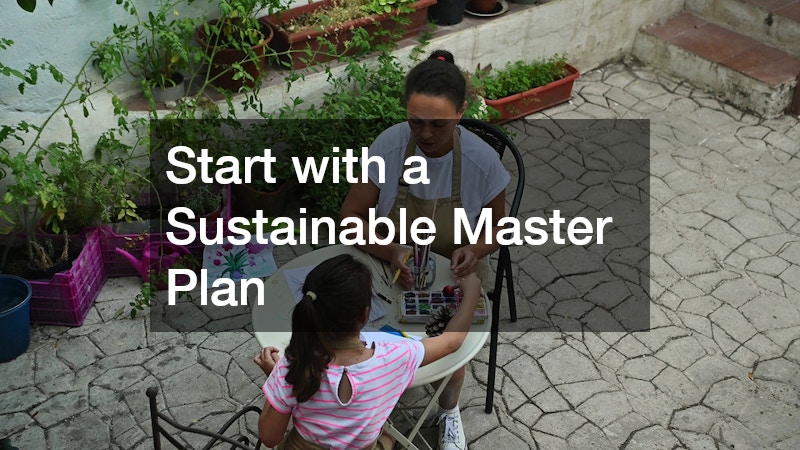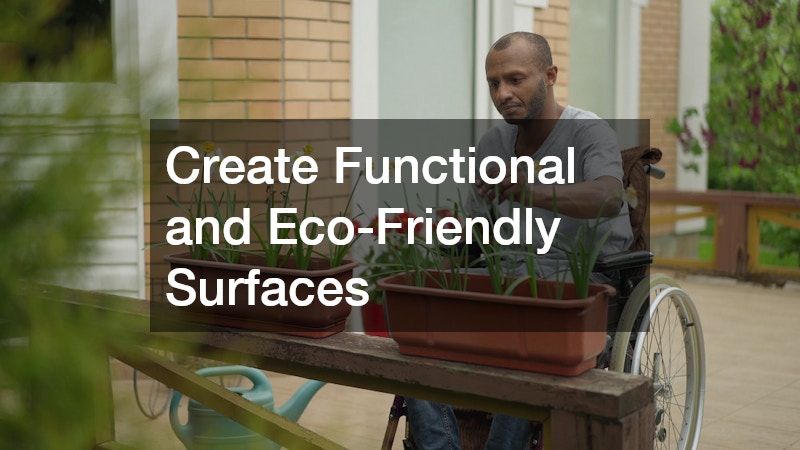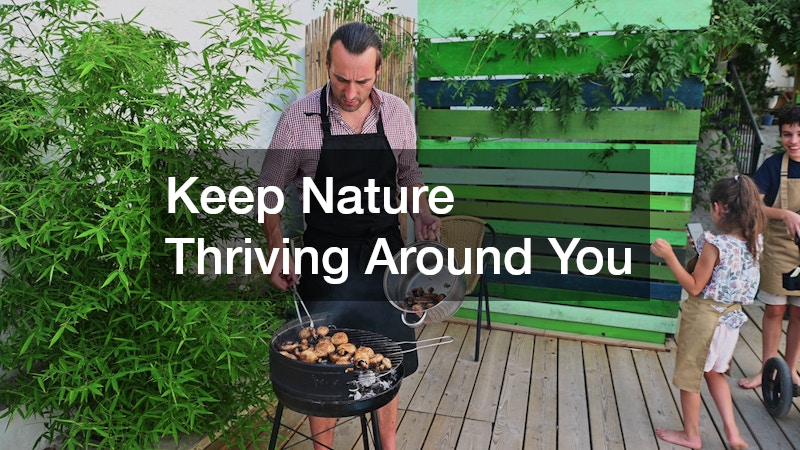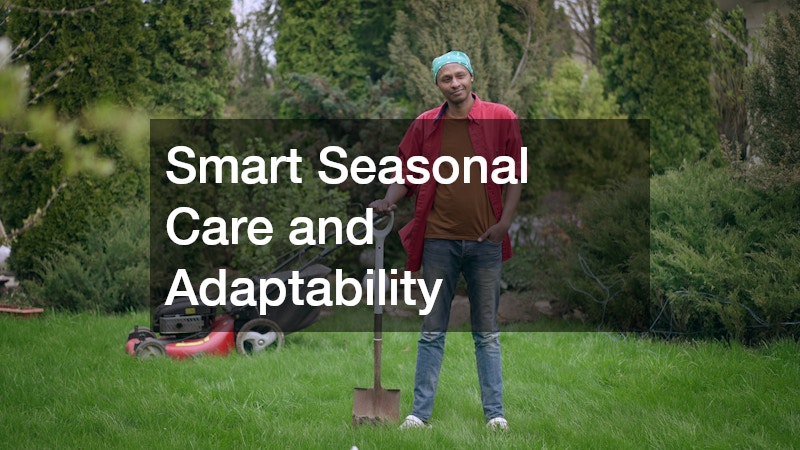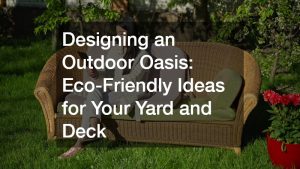Picture this: you step outside and find yourself in a serene, green space that feels like a natural extension of your home. The air is fresh, the landscape feels balanced, and every element — from the plants to the seating area — works in harmony. An outdoor oasis like this isn’t just about aesthetics; it’s about living sustainably, reducing waste, and creating a space that nurtures both you and the environment.
Eco-friendly outdoor design is about intentional choices. It’s about selecting materials that last, working with your landscape instead of against it, and finding beauty in efficiency. The best designs bring together nature, comfort, and practicality. This guide explores how to build a backyard retreat that’s environmentally conscious, long-lasting, and deeply satisfying — from the ground up.
Start with a Sustainable Master Plan
Every successful outdoor space begins with a thoughtful plan. A well-designed layout ensures your yard looks cohesive while promoting water conservation, soil health, and energy efficiency.
Professionals who specialize in outdoor environments can help you achieve this balance. Skilled landscape designers have the expertise to visualize how your property interacts with sunlight, rainfall, and existing vegetation. They can recommend plants that thrive naturally in your climate, reducing the need for constant watering or fertilizers. With their guidance, every corner of your yard serves a purpose — whether it’s capturing rainwater, providing shade, or attracting pollinators.
Trees, in particular, play an essential role in any eco-friendly design. Instead of removing them to clear space, consider working with local tree services to evaluate their health and longevity. A mature tree can offer natural cooling, privacy, and beauty that no structure can replicate. Tree experts can trim branches safely, treat diseases, and help your existing greenery integrate seamlessly with new elements of your yard.
When planning your space, think long-term:
-
Use native plants that adapt naturally to local conditions.
-
Group vegetation according to water and sunlight needs.
-
Design pathways and patios around established trees to preserve their root systems.
-
Create shaded zones to cut down on home cooling costs.
By treating your outdoor area as a living system rather than a decoration, you set the stage for a truly sustainable environment.
Build a Strong and Sustainable Foundation
Once the vision is clear, it’s time to prepare the land and structure. The foundation of your outdoor oasis determines how well it will withstand time and weather — and how lightly it treads on the environment.
If your design includes an elevated lounging space, a custom deck is the perfect feature to merge indoor and outdoor living. The key to sustainability here lies in thoughtful design and placement. A deck positioned to catch gentle breezes or morning sun reduces reliance on fans and heaters. Integrated benches, planters, and railings made from natural materials create a cohesive, clutter-free look while enhancing functionality.
Preparing the ground for such structures requires care. Many homeowners rent excavation equipment to level slopes or install foundations, but few consider the environmental side of this process. Choosing an excavator rental company that maintains energy-efficient or low-emission machinery makes a difference. Proper soil management and erosion control during digging prevent runoff and protect your landscape’s natural balance.
When you’re ready to build:
-
Use gravel or crushed rock under your deck for drainage.
-
Avoid removing topsoil unnecessarily; it supports healthy ground cover later.
-
Direct rainwater runoff away from the house and toward garden beds.
Sustainability starts from the ground up — and the decisions you make early on will influence how eco-friendly your outdoor space truly becomes.
Choose Durable and Green Building Materials
The materials that make up your outdoor space define its longevity and its environmental footprint. One of the most important choices you’ll make is what type of wood to use for your deck, pergola, or fencing.
Opt for responsibly sourced lumber that comes from sustainable forests or reclaimed sources. Certified wood ensures that you’re not contributing to deforestation, and reclaimed timber offers a unique, weathered charm. Species like cedar and redwood are naturally resistant to decay, which means fewer chemical treatments and longer lifespans.
Beyond wood, other materials can help you build greener structures. If your outdoor oasis includes shaded seating or a covered deck, experienced roofing contractors can suggest reflective or recycled roofing options. Light-colored or metal roofs bounce sunlight away, keeping your deck and adjacent rooms cooler in the summer. Some homeowners even explore partial green roofs, where vegetation grows above structures to absorb heat and rainwater.
To make your project both beautiful and sustainable:
-
Use reclaimed beams and panels for rustic, low-impact accents.
-
Choose natural or plant-based stains to protect wood surfaces.
-
Incorporate locally sourced materials whenever possible to reduce transport emissions.
Durable, eco-conscious materials don’t just protect the planet — they also save you money over time by reducing maintenance and replacements.
Create Functional and Eco-Friendly Surfaces
Hardscaping — the paved and structured elements of your yard — can either work with nature or fight against it. The key to a sustainable outdoor oasis is designing surfaces that allow the land to breathe.
Modern paving companies now offer permeable materials that let water soak into the soil rather than running off into drains. This reduces erosion, prevents flooding, and helps replenish groundwater. Recycled concrete, natural stone, and even crushed shells can add character while keeping your carbon footprint low.
The connection between your outdoor and indoor environments is also part of eco-conscious design. Simple home upgrades like energy-efficient window treatment options — such as solar shades or reflective blinds — help regulate temperature and reduce glare from outside surfaces. By controlling how sunlight enters your home, these treatments keep interiors cooler and lessen the load on air conditioning systems.
Consider these practical ways to make surfaces work smarter:
-
Use light-colored pavers to reflect heat and keep walkways cooler.
-
Choose irregular stone patterns to reduce material waste.
-
Design pathways that direct rainwater toward garden beds or rain barrels.
When your hardscaping allows water, light, and air to move naturally, your yard stays cooler, healthier, and more resilient through the seasons.
Focus on Maintenance and Longevity
Sustainability isn’t just about how you build — it’s also about how you maintain. Regular care prevents small issues from becoming big environmental and financial problems.
Your home’s exterior systems should blend seamlessly with your outdoor space. Something as simple as timely garage door repair contributes to overall efficiency. A door that closes properly helps stabilize indoor temperatures, reducing wasted energy and prolonging the lifespan of mechanical components. It’s a small act of maintenance with a surprisingly large impact.
Another crucial aspect of eco-friendly upkeep is managing unwanted pests naturally. Instead of harsh chemicals, adopt pest control strategies that respect the ecosystem. Beneficial insects like ladybugs and lacewings help manage aphids and mites, while certain herbs — such as mint or lavender — naturally repel mosquitoes and flies. Maintaining soil health through composting also creates an environment where plants can resist infestations naturally.
Simple maintenance practices to build into your routine:
-
Inspect outdoor structures each season to address wear early.
-
Keep drainage clear to prevent standing water.
-
Encourage birds and bats to inhabit your garden for natural pest management.
Caring for your home and yard responsibly ensures that your eco-oasis thrives for years to come without unnecessary waste.
Blend Comfort and Conservation in Design
Eco-friendly spaces can be luxurious too. The secret lies in integrating comfort features that work with nature, not against it.
A custom deck can double as a cooling system for your home if designed strategically. By orienting it to capture prevailing breezes, you can create natural airflow that reduces the need for fans. Pairing the deck with retractable shades or climbing plants over pergolas adds another layer of comfort while moderating sunlight exposure.
Inside the home, matching this design approach with smart window treatment options — such as motorized blinds or thermal curtains — helps balance light and temperature. When indoor and outdoor shading work together, energy usage drops dramatically, and comfort levels rise.
Think about comfort holistically:
-
Align decks with morning or evening sun exposure depending on your climate.
-
Use layered shading: awnings, plants, and blinds that adjust with the season.
-
Choose materials that stay cool to the touch, even on hot days.
By blending human comfort with environmental awareness, you create a space that feels effortless and alive — one that evolves with the seasons instead of fighting them.
Keep Nature Thriving Around You
The healthiest outdoor spaces are those that support a wide range of life. An eco-friendly yard doesn’t just serve its owners; it sustains pollinators, birds, and other wildlife that keep the ecosystem in balance.
Thoughtful planting, guided by knowledgeable landscape designers, can transform a yard into a small haven for biodiversity. A mix of flowering plants, native shrubs, and layered greenery provides food and shelter for pollinators and beneficial insects. Over time, your yard becomes more self-sustaining, with fewer weeds and pests.
Equally important is the ongoing care of mature trees. Partnering with local tree services ensures your canopy stays healthy and resilient. Professionals can assess trees for disease, prune them to promote growth, and protect root systems during construction or landscaping projects.
To encourage thriving biodiversity:
-
Add birdbaths, bee hotels, and native flowering species.
-
Compost leaves and clippings to feed the soil naturally.
-
Create shaded areas with layered planting to mimic natural habitats.
Your backyard can become a small ecosystem that contributes to the health of the planet — a place where nature and design coexist beautifully.
Long-Term Sustainability and Community Impact
True sustainability doesn’t stop at the property line. The materials and methods you choose affect the wider community — from local water quality to air purity.
When building or renovating, seek out paving companies that reuse materials and reduce waste. Many now recycle old asphalt or concrete, keeping tons of debris out of landfills. Similarly, selecting an excavator rental company that maintains efficient, low-emission machinery helps reduce pollution during construction.
These decisions set an example for your neighborhood. When others see how green design adds both beauty and value, they’re more likely to follow suit. Sustainable design can spark collective change — a ripple effect that extends far beyond your own yard.
Ways to build community-minded sustainability:
-
Buy from local suppliers to reduce transportation emissions.
-
Encourage neighbors to install permeable driveways or rain gardens.
-
Organize a local compost or tree-planting initiative.
A shared commitment to sustainability not only strengthens neighborhoods but also builds a sense of connection rooted in care for the environment.
Practical Eco-Luxury Additions
Sustainability doesn’t have to feel minimal or austere. With the right materials and craftsmanship, eco-friendly choices can elevate your space and enhance comfort.
For shaded or covered areas, working with skilled roofing contractors can help you integrate both function and beauty. Options like solar-reflective panels or even small green roof systems keep areas cool and provide additional insulation. These features extend the usability of your outdoor areas throughout the year, from hot summers to rainy seasons.
Complement these structures with responsibly sourced lumber for natural seating, fences, and decorative features. Reclaimed beams can become elegant benches or rustic pergola supports, while untreated cedar and teak provide natural resistance to moisture.
Small upgrades that feel luxurious yet responsible include:
-
Built-in wooden planters made from recycled materials.
-
Outdoor furniture crafted from reclaimed wood or bamboo.
-
Subtle solar lighting to illuminate pathways without draining energy.
Luxury and sustainability are not opposites — they’re partners in creating spaces that feel timeless, comfortable, and guilt-free.
Smart Seasonal Care and Adaptability
Every eco-friendly yard evolves over time. Keeping your space adaptable ensures it stays functional and sustainable through changing seasons.
Routine maintenance — such as keeping your garage systems in top condition — plays a surprisingly big role in sustainability. Regular garage door repair prevents air leaks, protects tools and materials, and keeps the system efficient. These small steps contribute to the overall energy balance of your home.
Seasonal care also includes natural pest management. Instead of reactive spraying, focus on prevention. Rotate garden crops, clean debris regularly, and introduce companion plants that repel pests naturally. Herbs like rosemary or basil deter insects while adding aroma and flavor to your cooking.
Some seasonal tasks to keep your oasis in peak condition:
-
Inspect decks, fences, and walkways for winter wear.
-
Compost fallen leaves instead of discarding them.
-
Refresh mulch and soil to retain moisture during dry months.
Sustainable living isn’t about perfection — it’s about consistency. The more you build these habits into your routine, the easier it becomes to maintain a green, thriving outdoor retreat.
Designing an eco-friendly outdoor oasis means thinking beyond appearances. It’s about creating a relationship between your home and the environment — one that’s practical, balanced, and beautiful. Every decision, from plant selection to maintenance routines, influences how your space functions within the larger ecosystem.
The rewards of sustainability are lasting: lower utility bills, healthier plants, and a deeper connection to the natural world just outside your door. Start small, stay curious, and allow your space to evolve naturally over time. Your backyard can become a living example of how thoughtful design and environmental respect create comfort that endures — for you, your community, and the planet.

